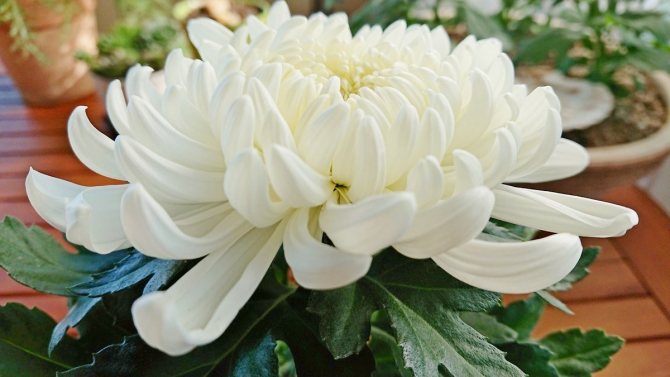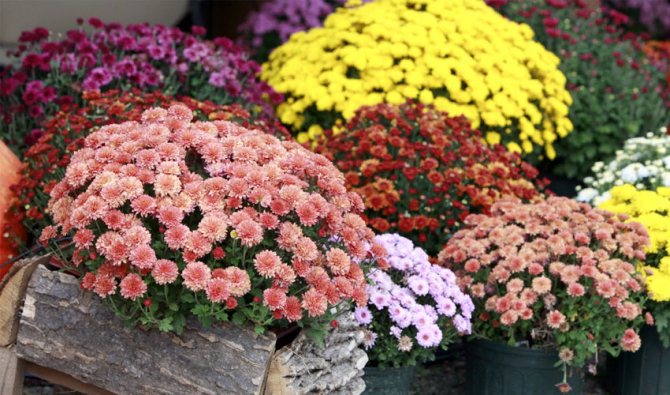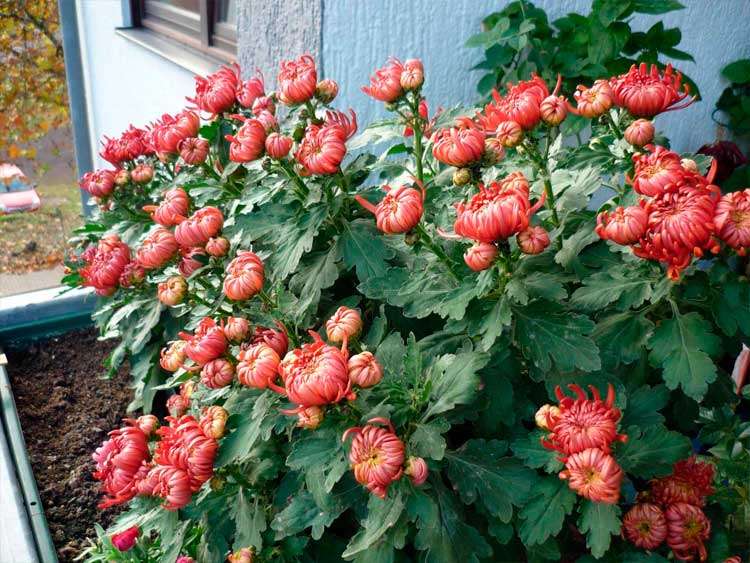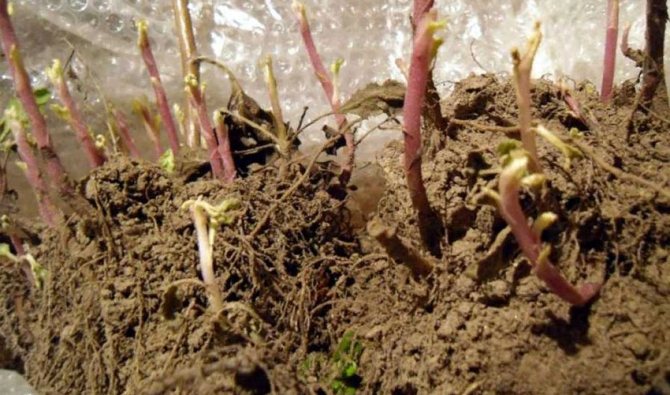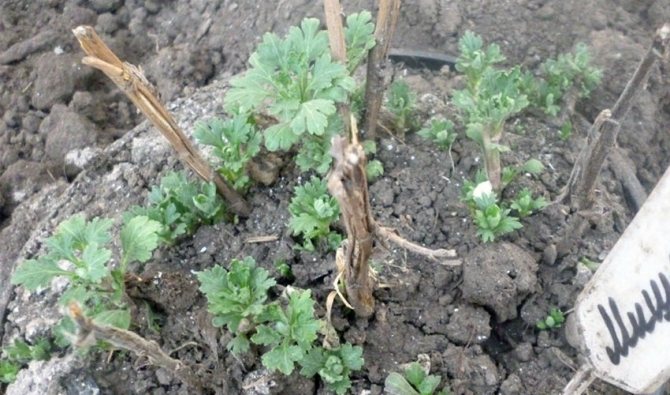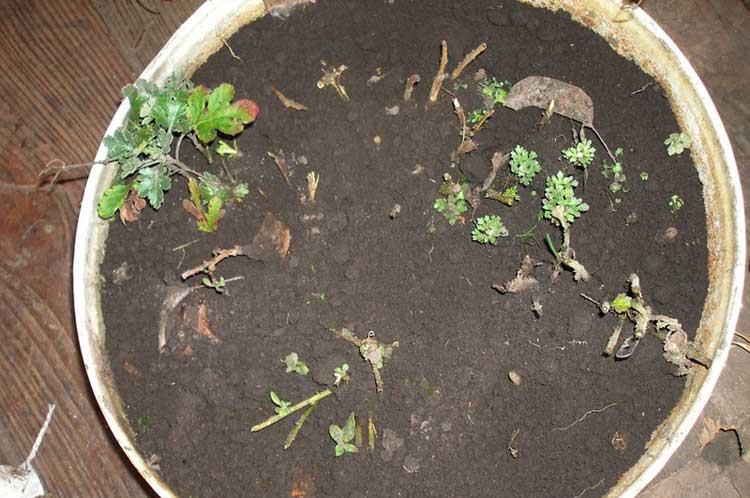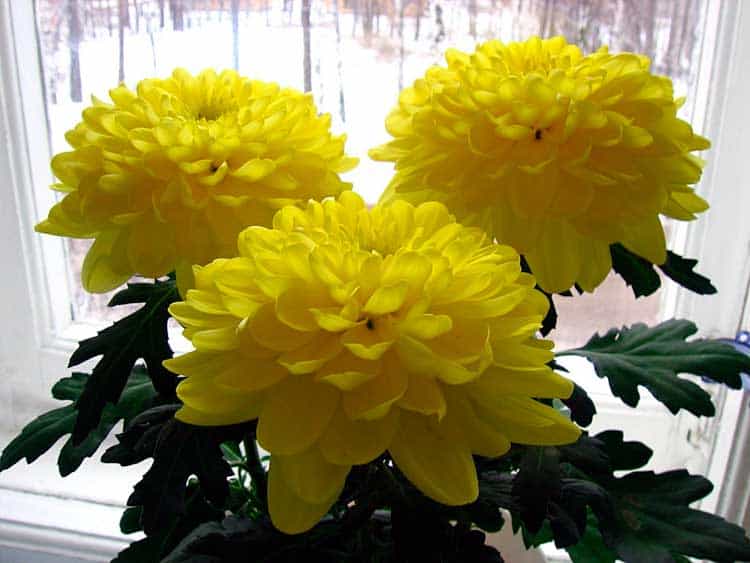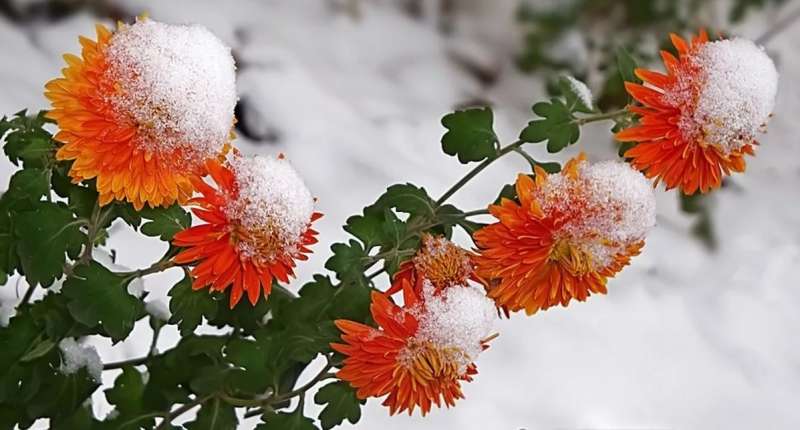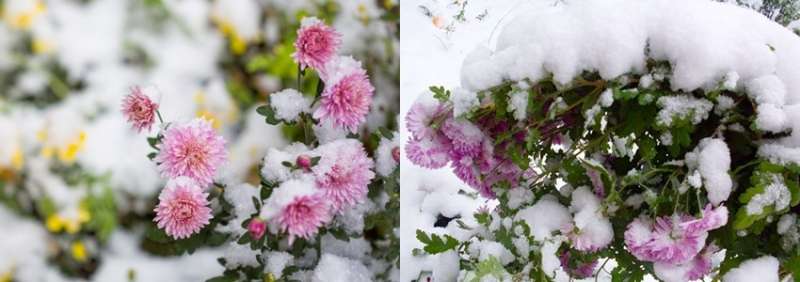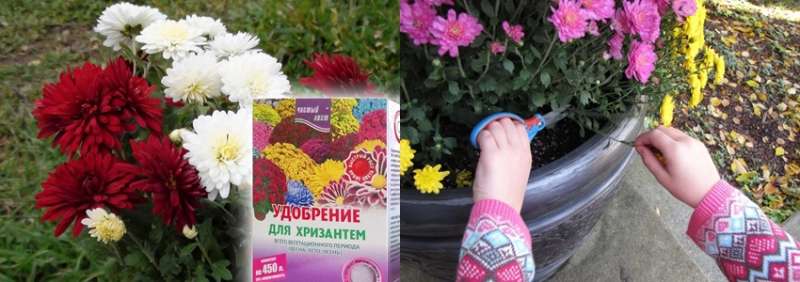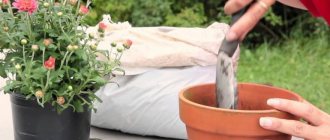I was presented with a pot of chrysanthemum in the fall. The beauty is extraordinary, and it is also pleasant. Despite the fact that I do not know which variety, this flower grows well. I try to look after him. But then I wondered, how will my chrysanthemum winter? How to preserve it so that the plant will continue to delight the eye with beautiful flowering? Another question arose: how to transplant into the garden and when is it better to do it? In this article, I want to share the information I found on how to keep chrysanthemums in pots in winter and how to prune them.
Varieties
Zoned varieties of chrysanthemums can survive the winter in a flower bed, but there are some that need to be dug up. These are mainly compact gift bushes or Indian specimens rooted from bouquets. When planted in the ground, the dwarf chrysanthemum will grow, the bush will fall apart, but the flowering will remain. If you leave this variety outside for the winter, it will freeze. Many Indian varieties are also cold-tolerant.
If there are no suitable premises for winter overexposure of chrysanthemums, then it is advisable to acquire cold-resistant species. These include:
- Oak;
- Korean;
- Everest;
- Purple Haze;
- Red Moscow.
The flowers and leaves of these chrysanthemums are smaller, but they are less demanding on climatic conditions, patiently endure the winter cold.
Advice
Many growers believe that in regions with frosty winters, all chrysanthemums need to be dug up for the winter, regardless of their cold resistance. Such bushes grow faster in the spring, almost do not get sick and bloom magnificently.
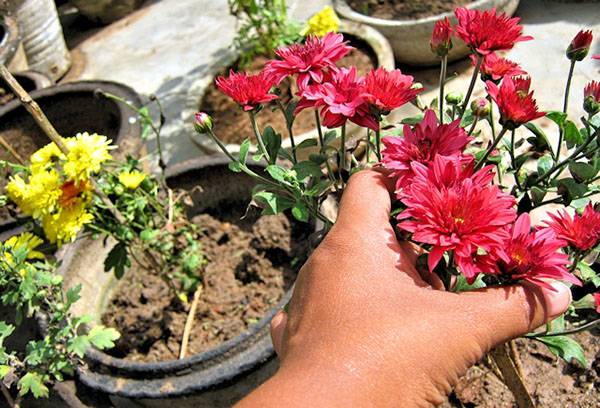
How to care in winter
- To continue flowering, many advise the use of growth stimulants and biostimulants, which include drugs such as Zircon and Bud.
- Periodically, it is necessary to inspect the dense crown of the plant and remove dried yellowed leaves at the bottom of the shoots. It is there that pest larvae and pathogenic bacteria most often accumulate. It is also necessary to remove all faded buds. Then the flowering period will last for a longer period.
- If you left the plant outside, be sure to tie it up so that strong wind or rain does not break the bush.
- Pinch the tops of the shoots so that the bushes don't grow too much.
- Important: when watering, try to prevent water from getting on the leaf plates of the plant. Otherwise, infections or fungal diseases may start there.
Reasons for the lack of flowering chrysanthemums in the fall
Sometimes it happens that for some reason the plant does not begin to bloom in due time. What are the reasons for the lack of bud formation? There may be several of them.
- One of the main reasons may be a lack of light or an excess of it. If the daylight hours are less than 7 hours, then the flowering period may not wait. Try additional fluorescent lighting on the plant.
- If it's too late pruning or pinching the twigs.
- Poor soil composition, deficiency of potassium and phosphorus, which contribute to abundant and prolonged flowering.
- When the chrysanthemum is tall and bushy, it is a mistake to overfeed it with nitrogen-containing fertilizers. As a result, the green mass builds up, but flowering does not occur. It is necessary to fertilize with potassium - phosphorus fertilizers with a low nitrogen content.
- When the temperature in the room is more than 20 - 25 degrees, the chrysanthemum may refuse to bloom.
Indoor storage
The insulated basement of a private house allows you to solve all the problems with the preservation of not only vegetables and preparations, but also flower tubers and rhizomes.
Chrysanthemum should be dug up literally before the first frost. If a little later, then it is not critical. Previously, all the stems are cut to 10 cm. It is better to leave a lump of earth a little more. If the floor in the storage is not earthen, then the dug out rhizome is rolled over into a box or other container filled with a mixture of sand and peat (1: 1). Usually chrysanthemums are left under a canopy until stable frosts, since in the room the rhizomes can start growing and begin to lose strength.
The optimum temperature for wintering chrysanthemums in the basement or cellar is from 0 to + 4 ° С, permissible from -1 to + 5 ° С. If the floor is earthen, then the rhizomes are laid directly on it, tightly fitting them to each other. So they will not be ventilated, and there is enough natural moisture from the ground.
If there is no basement, then the following options are suitable:
- unheated country house or garage;
- veranda;
- solid barn;
- loggia.
Advice
Do not leave the dug chrysanthemum to winter at home. The plant feels the onset of a dormant period. Without adequate daylight hours and lack of ultraviolet radiation on the windowsill, it will wither and die.
Chrysanthemum rhizomes stored in country houses, garages or loggias should preferably be covered with breathable material. If possible, once a month, the containers are slightly moistened (this is especially important for the globular chrysanthemum). If a growth has appeared, then it must be cut off.
The main advantage of this method of preserving chrysanthemums is that, on the eve of spring, they can begin to germinate. To do this, at the beginning of March, the rhizome is transferred to a bright room with a temperature of about 15 ° C. As soon as sprouts begin to appear, they are carefully separated and transplanted into separate containers.
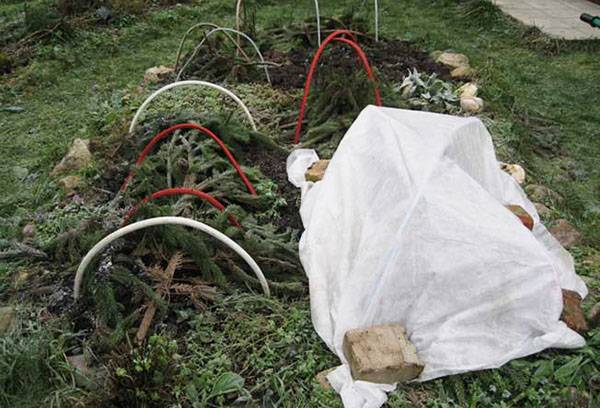

Necessary processing
If the plants have been infested with insects, they must be treated with insecticides. Then you can transfer the plants to the basements. Rhizomes can be placed on the basement floor or in boxes with earth, covered with a layer of soil 5-7 cm. The bushes are placed tightly. On top they are sprinkled with a substrate. Thus, the roots will constantly have access to moisture.
If the room is warm, the chrysanthemum may wake up and start growing in the middle of winter. This should not be the case, since the shoots will weaken and become very thin. It is advisable to place a thermometer in the room to control the temperature.
No other additional plant care activities are foreseen in winter. You just need to inspect them at least once every month. If sluggish or dried roots catch your eye, it means that they lack moisture. You need to spray the root system with water. If mold has become noticeable on the roots, the plants should be removed from the basement, and the remaining bushes should be treated with antifungal agents. Basement storage is one of the most affordable traditional methods.
Outdoor storage
If there is no suitable room, then chrysanthemums can have a safe wintering outdoors. To do this, a trench is dug with dimensions of 50 * 50 or 70 * 70 cm. The rhizomes are tightly packed to the bottom (stems up), the voids are filled with peat or light soil.
As soon as the subzero temperature is established, they begin to shelter the chrysanthemums.
- The first thin layer should create volume and provide ventilation. Fragments of slate, light fittings, trimming corners are suitable. It is undesirable to use branches in order to avoid the development of fungus on chrysanthemums.
- The second layer (about 0.5 m) is warming and absorbing. These can be dry leaves (without scab and fungus) or chopped straw.
- The third layer protects the rhizomes of chrysanthemums from precipitation and damping. A piece of thick film or roofing material will do. At the edges, the material is fixed.
In such grooves, chrysanthemums successfully survive until spring. The downside is the inability to control the condition of the rhizomes.
Advice
Prudent summer residents harvest natural covering material throughout the season. This can be lawn mowed grass, straw, coniferous litter, pine cones, sawdust. All materials are dried and stored until winter.
Some owners of glass or polycarbonate greenhouses use them to store chrysanthemums in winter. The bushes are dug out before frost, transplanted into a greenhouse, where they continue to grow and bloom. After the minus temperature (about 5-7 ° C) is established, the stalks of chrysanthemums in the greenhouse are pruned, the bushes are covered with dry mulch and covered with lutrasil. In the spring, they begin to grow rapidly and are transferred to the flowerbed already strengthened.
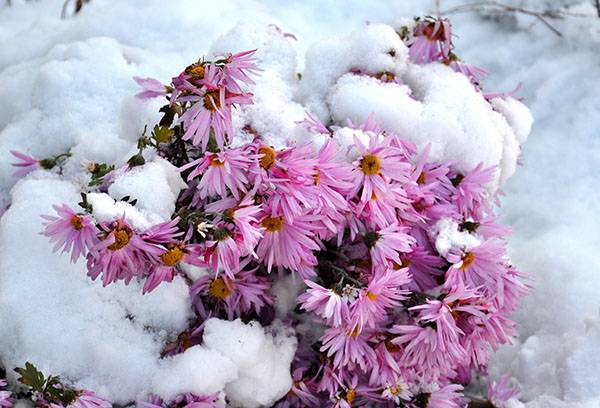

Where to store
The presence of an insulated basement in a country house greatly simplifies the storage of crops, conservation, and tubers (roots) of flowers.
Chrysanthemums should be stored under the following conditions:
- the presence of supply and exhaust ventilation;
- humidity not less than 70%;
- temperature from 0 ° С to + 4 ° С;
- lack of mold.
In rooms with earthen floors, the roots are laid directly on them in such a way that they fit snugly against each other. Then the tubers will not be weathered, and natural moisture will occur due to contact with the ground.
If the floors are not earthen, winter storage of chrysanthemums should take place in boxes. In this case, the roots are sprinkled with peat mixed with sand in a 1: 1 ratio.
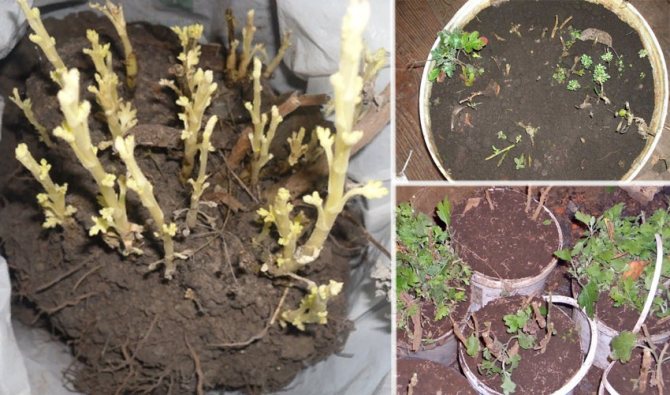

In the absence of a cellar or basement, other options are possible:
- garages without heating;
- verandas;
- glazed balconies.
Chrysanthemums should not be stored at room temperature in winter. The plant needs a dormant period. And if it continues to grow in winter, it will not have enough ultraviolet radiation and the duration of daylight hours. As a result, the flower will most likely die.
Rhizomes stored on balconies or garages need to be covered with foil. And the containers in which they are located should be periodically moistened (once a month). A normal humidity level for the globular chrysanthemum is very important.
If during storage the roots give a new growth, it will need to be cut off.
Wintering in a flowerbed
Cold-resistant garden chrysanthemums and in the open field will not suffer from frost in winter if they are properly prepared in the fall (without digging). After the first frost, the stems are pruned to 15 cm (young shoots do not need to be touched). It is useful to treat the hemp and the soil around it with a solution of copper sulfate (10 g per 0.5 l of water) or Bordeaux liquid - this will serve as the prevention of fungal diseases for the next season. Then the bush is slightly huddled. It is important that there are no grooves left where water accumulates.
At the second stage, dry mulch is poured (in a layer of 40-50 cm). It is desirable that the mixture contains rigid elements (cones, needles) that add volume and provide ventilation. On top, you can lay spruce branches or a couple of layers of covering material - it will provide air exchange and protect against precipitation.
Some, after the first frost hits the flowers, simply cut the chrysanthemums in the garden and surround them with spruce branches. It should be noted that the needles have disinfecting properties, so such a shelter will not provoke a fungal disease.
Preservation by cuttings
If chrysanthemums were purchased in late autumn and there is no way to arrange them for the winter in a suitable room, then you can leave the flowers in the apartment. However, there is no guarantee of their safety until spring (even with backlighting), so cuttings are used. Plants in pots are located on the windowsill closer to the window, away from the heating. Several cuttings (3-4 cm long) are plucked from the leaf sinuses. For their rooting, small cups filled with nutritious soil are prepared.
The planting technique is simple: a depression is made in the middle of the container, sand is poured into it, moistened, then the cutting is immersed (by about 1 cm). The glass is tied with a plastic bag, but loosely so that ventilation remains. In such a greenhouse, a chrysanthemum stalk usually "sits" for 1-2 months, and then starts to grow. As soon as the roots become visible through the walls of the container or the first leaves appear, the shelter is removed. Buds may form, but they are removed immediately. Healthy planting material will be ready by spring.
Chrysanthemums amaze with their varietal variety, brightness, original forms. But many are afraid to grow them precisely because of the risk of freezing. Fortunately, keeping chrysanthemum bushes until next season is not difficult, even if there is no suitable space.
Features of growing and caring for a dwarf chrysanthemum
Chrysanthemum is unpretentious, your attention and care in winter is important for it. At the end of February, the plant will start to grow, do not miss.
At this time, a flower pot needs move to a warmer room (on the veranda), where the temperature can be up to 15 ° C.
In summer, plants are afraid of drought.... You need to water Multiflora every week, sometimes more often. Some growers, when digging in before watering, add banana peels to the soil, containing magnesium useful for the plant.
Excessive watering can also harm globular chrysanthemums, it provokes diseases. During the budding period (June - July), Multiflora will need abundant watering.
Plants need to be watered only at the root, sprinkling is not applied. During the flowering period, watering is stopped.
Planting and caring for chrysanthemums:
Divide the Multiflora rhizome every 2-3 years, otherwise the spectacular bush will gradually lose its decorative effect.
Do not get carried away with the introduction of nitrogenous fertilizers, this provokes the defeat of aphids. This is especially true for manure and garden humus.
Later, fertilizing is carried out with potash and magnesium fertilizers, which help the plant at the budding stage.
Take your time to cut chrysanthemums in autumn, the plant needs to form growth points for the next year. Wait for the flowers to dry. This means that the plant is ready for wintering.
Early pruning can affect the growth of dormant buds, which is harmful to the plant.


